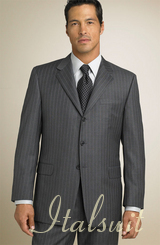About Men's Suits

Most first impression of the word “wool” is a cozy warmth or cozy feeling fabric. Types of wools are the Super 100's , 120's and 150's. Rationally speaking, wool fabric come from variety of animal coats, however not all has a soft or scratchy feel. The wool fiber has curls, which creates pockets, and give the wool a spongy feel and insulation on the wearer. While the outside surface of the fiber consists of series of ragged scales that overlaps with each other, just like the fish, their scales overlaps to each other.
The serrated scales tend to stick or cling to each other, worst, they shrink if improperly cleaned.
The fascinating fact about wool, it does not only return to its original shape with its exceptional properties, it also absorbs its weight and moisture without feeling damp when cleaned properly. They are dirt and flame resistant and resist wear and tear, making wool the most admired and known for its superiority as a garment.
There are two processing in wool construction
.
1. Woolen fabrics
-
has a soft and fluffy surface, not much shinny feel or sheen, does not hold the crease and is much heavier and bulkier.
(blankets, scarves etc, are considered woolens)
2. Worsted Wools
-
is smoother than woolen. It holds the crease well lighter and less bulky. Such fabric requires a greater number of processing since fibers are set up parallel to each other. The smoother, harder-surface worsted yarn produces smoother fabrics with less uncertainty. They are cooler feel to the wearer, as the weave fabric allows wool to absorb perspiration and breathes, unlike other fabric that are quite firm to wear
.
Related Terminologies About Wool Classification:
Beaver Cloth
-
a plush fabric that are used for hats
Merino Wool
-
a fine fabric made from worsted wool yarn
Broadcloth
-
an all-woolen or worsted fabric with velvety feel.
Tartan
-
twilled palid design, originally Scottish
Tweed
-
a rough textured wool, ordinary fabric and are slightly felted. A strong fabric has spotty color
.
Sharkskin
-
woven with warp yarns. Has an alternating colors: black, brown, or blue
Jersey
-
knit fabric and fine wool, found in silk. This are man-made fibers
Gabardine
-
tightly woven wool twill with a high sheen, excellent tailoring fabric.
Flannel
-
soft, lightweight fabric with a nap on one or both sides
Felt-
fabric is a compact sheet of entangled, not woven wool, fur, sometimes and cotton fibers. The felt are manufactured by processing mat fibers with moisture, heat and pressure.
Challis
-
lightweight, soft wool in plain weave, could have various designs such as flowers or figures.
Some Wool Specialty Fibers
: (but still classified as wool, from which animals they came from)
Angora Wool
-
comes from a rabbit, commonly used in sweaters, mittens and infant wear.
Alpaca Fleece
-
is very rich and silky with considerably luster
Mohair
-
is from angora goat is highly flexible and strong, used in home decorating fabrics as well as garment fabrics including tropical worsted.
Cashmere-
is separation of the soft fibers from the long coarse hair, dull and difficult. The soft hair are woven and knitted that could blend to silk, cotton or wool.
Camel Hair
-
they are extremely soft and fine. They come from the under coat of the camel, though camel’s hair could be used by itself, combined with a fine wool for over coating, top coating, sportswear and sports hosiery. They are lightweight and soft that could give you enough warmth.
Vicuna
-
the softest coat cloth you could ever find. It comes from a llama family, which are small and wild.
“The finest animal fiber worldwide”
.
These animals obtain the fleece and are highly protected and meticulously conserved with
professional measures. These are very rare fiber, and are very costly due to its finest feel.

